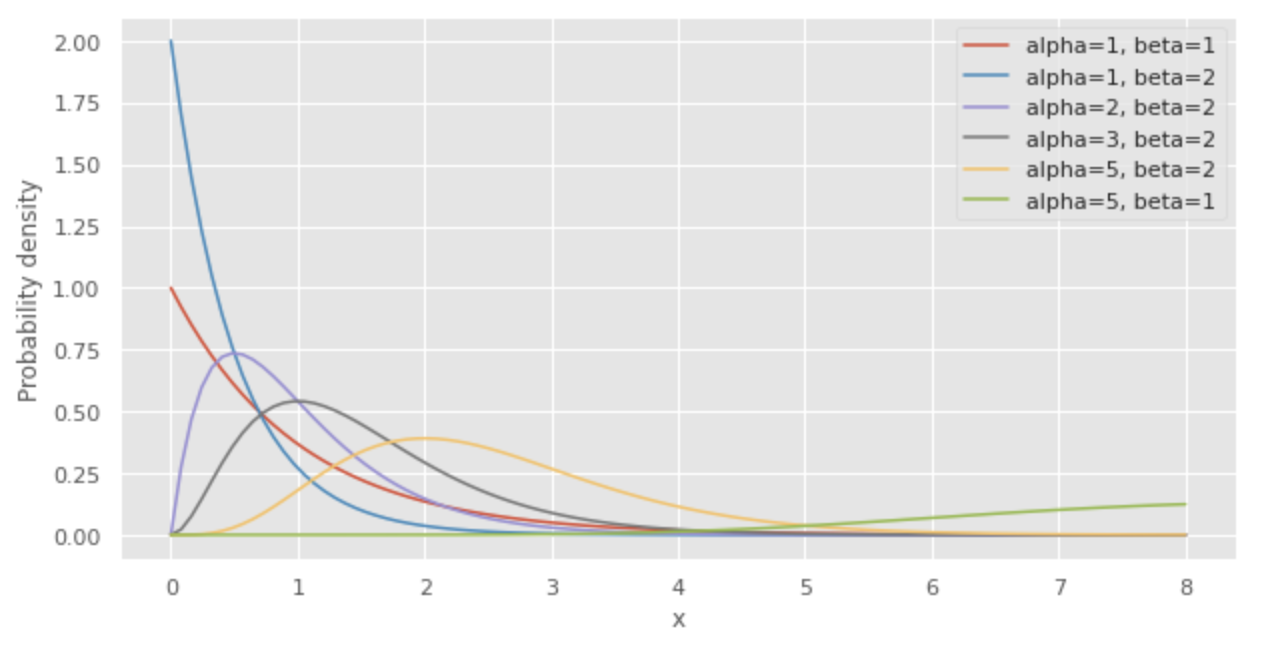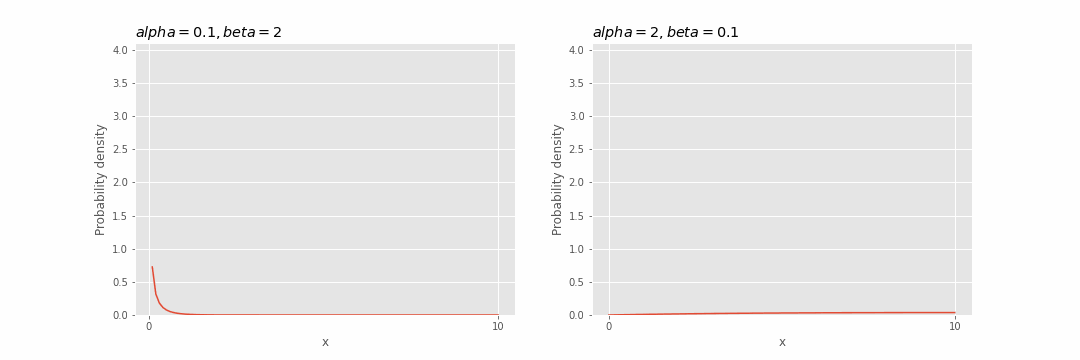What is gamma distribution
The gamma distribution is the probability distribution that
- Person's weight
- Virus incubation period
- Latency to system downtime
- Lifetime of an electronic component
The probability density function of the gamma distribution is expressed by the following equation:
The gamma distribution has

Relationship with exponential distribution
The exponential distribution coincides with the gamma distribution when
Substituting
The above equation is consistent with the probability density function of an exponential distribution whose expected value is
Expected value and variance of gamma distribution
The expected value and variance of the gamma distribution are respectively:
Effect of parameters on gamma distribution
Visualize the effect of the parameters

We can see that the larger
Reproductive property of gamma distribution
Suppose that the random variables
Then, from the reproductive property of the gamma distribution,
Python Code
The Python code used in this project is as follows.
Draw gamma distribution
import numpy as np
from scipy.stats import gamma
import matplotlib.pyplot as plt
plt.style.use('ggplot')
fig, ax = plt.subplots(facecolor="w", figsize=(10, 5))
# x axis
x = np.linspace(0, 8, 100)
# draw graph
plt.plot(x, gamma.pdf(x, 1, 0, scale=1/1), label='alpha=1, beta=1')
plt.plot(x, gamma.pdf(x, 1, 0, scale=1/2), label='alpha=1, beta=2')
plt.plot(x, gamma.pdf(x, 2, 0, scale=1/2), label='alpha=2, beta=2')
plt.plot(x, gamma.pdf(x, 3, 0, scale=1/2), label='alpha=3, beta=2')
plt.plot(x, gamma.pdf(x, 5, 0, scale=1/2), label='alpha=5, beta=2')
plt.plot(x, gamma.pdf(x, 10, 0, scale=1/1), label='alpha=5, beta=1')
plt.legend()
plt.xlabel("x")
plt.ylabel("Probability density")
plt.show()

Draw the effect of parameters on gamma distribution
import numpy as np
from scipy.stats import gamma
import matplotlib
import matplotlib.pyplot as plt
from matplotlib import animation, rc
from matplotlib.animation import FuncAnimation
rc('animation', html='html5')
np.random.seed(5)
# Set up formatting for the movie files
Writer = animation.writers['ffmpeg']
writer = Writer(fps=15, metadata=dict(artist='Me'), bitrate=1800)
prob_vals = np.arange(start=0.1, stop=10.01, step=0.2)
plt.style.use('ggplot')
fig, ax = plt.subplots(facecolor="w", figsize=(15, 5))
# x axis
x = np.linspace(0, 10, 100)
def update(i):
p = prob_vals[i]
# alpha graph
plt.subplot(1, 2, 1)
plt.cla()
plt.plot(x, gamma.pdf(x, round(p, 1), 0, scale=1/2))
# plt.plot(x, gamma.pdf(x, 2, 0, scale=1/round(p, 1)))
plt.title(f'$alpha={str(round(p, 1))}, beta=2$', loc='left')
plt.xlabel("x")
plt.ylabel("Probability density")
plt.ylim(0, 4.1)
plt.xticks(ticks=[0, 10]) # x axis ticks
# beta graph
plt.subplot(1, 2, 2)
plt.cla()
plt.plot(x, gamma.pdf(x, 2, 0, scale=1/round(p, 1)))
plt.title(f'$alpha=2, beta={str(round(p, 1))}$', loc='left')
plt.xlabel("x")
plt.ylabel("Probability density")
plt.ylim(0, 4.1)
plt.xticks(ticks=[0, 10]) # x axis ticks
anime_prob = FuncAnimation(fig, update, frames=len(prob_vals), interval=1000)
anime_prob.save('gamma_dist.gif', writer='pillow', fps=10)
